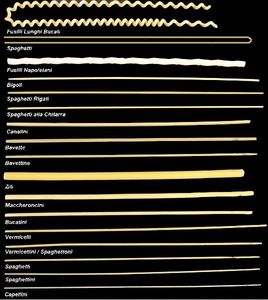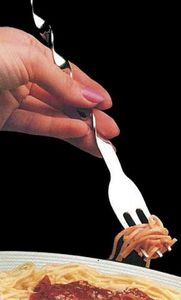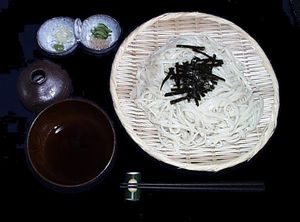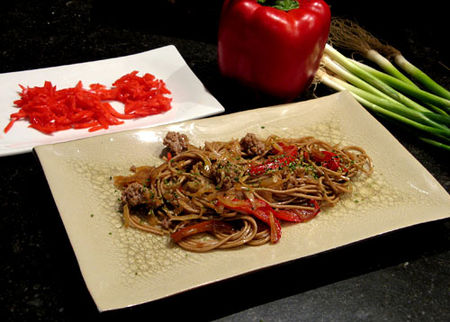Pastas !
- Vth millenium ante J.C. : In the zone of current China, there are testimonies of similar products in pastas. (Another manipulation of the Monster on the dating).
- IIth millenium ante J.C. : Noodles of the néolitique found in china.

To Lajia on Yellow River, A kind of Chinese Pompeï after a torrent. Professor Kam-biu Liu: " it is this unique combination of factors that created of the vacuum between the height of the cone of sediments and the bottom of this bowl of noodles which allowed them to be protected " professor Lu Houyuan: these noodles were made by using the grains of millet - contrary modern noodles, which are made with the wheat flour.
Three written tablets there akkadien and cuneiform characters, dating of 4000 years ago. Jean Bottéro translated them into French at the end of XX ° century and republished in 2002.
These texts mention several types of pastas : risnatu, bapirru, qaiiatu. Risnatu and bapirru are synonymic. The first one is an akkadien deriving word of rasanu, whereas the second is Sumerian and results to bappir. These verbs imply that some flour (of wheat even of barley, native (autochtonous) cereal of Mesopotamia) is molded with some water to realize a dough roll. Besides, the expressions hasalu and napu used by recipes imply, on one hand, that the patôn is grated against a sieve and, of the other one, that the glitter so obtained is poached in one me (consommé). Consequently, the bappiru / risnatu is on the base of a called crumbled pasta grattugiata dough in Italian.
As for the qaiiatu, he diverted of qalu meaning roasted grain and can, too, be crumbled. it gets closer from then on to the also burned) out and crumbled or rolled Sardinian fregola.
Risnatu is, besides, at the origin of the Arabian rishta - Persians, also relating to pastas with soup; these are not however crumbled but not cut from one
The invention of the writing:
As to Chinese, the invention of the writing, would be due to the worn dough roll, which would have at first served to read the future through the random forms obtained from the grater of the Dough roll. Then these forms were ordered to give it sense: forming idioms finally cuneiform . The writing put much more time than in china to be imperative(to lead) in these parts of the country, because Akkadien was greedy, and resisted badly to waste these graters of Dough roll, before realizing the linguistic interest (of the oral character in the oralisation). The writing took its development there only when the forms were Printed in tablets of clay (this above), much less delicious then.
It will have escaped nobody that the Chinese writing was in itself an unlimited evocation of Its Spatial Savourness. For a very good reason, from the genesis Its Tentaclely Dragonity offered to the Chinese people the writing, who mades it better usage than the Babylonians. So, ,Its Celestial Ingenuity arranged Pâstas in diverse assemblies to make it idioms, which Chinese can learn to read, and to be passed on the knowledge of any things. 麵 粉
We find this secular tradition in west through alphabet-Pastas which made the delights of many toddlers' generations...
.
Well, the Japanese one had to wait a little: Its Sensual Noodlyness Al dente had theological questions of first importance to be previously fathomed:
.
.
.
.
.
This below, evocation of the first idioms:
Greco-Roman pastas
In the Greco-Latin literature, pastas appear under three namings: tracta(e), lagana and itria 1. Tractae (or tracta) The compilation of the IVth - 5th century AD, known under the name of Of re coquinariae, awarded wrongly to the Roman gastronome of the 1st century Apicius (it was published and translated into French by Jacques André in 1974), quotes repeatedly tractae. They are various sorts. Some recipes, advise to crumble (confringere ) a beforehand dried dough roll and then to poach "crumbs", in the instar thus risnatu-s / bappiru-s. Two recipes were realized, the pullus tractogalatus and the minutal In the Greco-Roman literature, the laganum (Latin term, corresponding to the laganon or the itrion Greek), indicates generally a fine rolled-out pastry obtained by lamination. She can be cooked as well in damp environment as in the dry heat. The poached lagana is the ancestors of lasagnes, who derive from it besides etymologically.The word lagana ( lagane ) is moreover still used in certain regions of Southern Italy (Calabria, Puglia) De re coquinaria Use lagana to make two patina (= terrines) : patina cotidiana and patina apiciana which are based on a superimposing of lagana alternating with various layers of a wet practical stuffing consisted of several flesh (chicken, pork, fish) mixed with eggs and coated by a sauce with garum (brine of fish which remains in particular in Italy under the name of colatura alici di (= anchovy) of Cetara (near Salerme), some wine, some straw wine, some olive oil. These lasagnes present the peculiarity to be cooked in a pastry case, as a pâté and inaugurate the preparations of " pasta in the pasta " which we shall find of the Middle Ages in our days.
|
|
Les formes et les couleurs sont innombrables. Les pâtes ont différentes formes pour que la sauce accroche mieux et ne reste pas au fond de l'assiette (comme parfois avec les spaghettis, par exemple). On peut les classer dans les principales catégories suivantes :

  | ||
Différents bénédicités : ut exultetis et satiemini ab uberibus consolationis vestræ exultez et rassasiez-vous à l'abondance de ses délices Pâstas vivus et vitalis Hodie proponitur La Pâsta vivante et vivifiante, aujourd'hui nous est proposée Credo in Spiritum Pâstum, Dominum, et vivificantem Je crois en la Sainte Pâte, Maîtresse qui donne la vie Gloria in excelsis Pesto Gloire à ta Sauce au plus haut des cieux Pâstus Monstri, qui donis penna mundi, dona nobis pacem Pâtes du Monstre, toi qui apportes les Pennes au monde, donnes nous la Paix Ad fimandum cor sincerum, Sola Pâstes sufficit pour affermir un coeur sincère, la Pâsta seule suffit Et Pesto Pâsti omnipotentis, descendat super vos Et que la sauce de la Pâsta toute-puissante, descende sur vous Never of oil in the boiling water you will put !...
Pastafaris, fratelli miei, Here is the Bible of the cooking of pastas (pasta asciutta) : Twelve principles for a good cooking :
Tafù. Ramen.. And then "Mantecare" pastas in a frying pan with wipe them so that the miracle comes true. Nerone Une recette consacrée par Sa Savoureté Hydro-Carbonée (bento) : The Chinese food Use a large number of varieties of noodles, traditional 麵, Simplified 面, pinyin miàn). Mian are noodles of wheat while 粉 Or fen are the ones of rice. There are in China the restaurants of district specialized in the fresh, hand-made pasta without any tool of cut. These pastas are called the miàn what means " stretched pastas ". The restaurants of the miàn are held by Hui, western Moslem, native Chinese of China. They do not sell dishes has pork's(pig) base, but they often sell some alcohol. The manufacturing of pastas is made from a dough roll of very supple(flexible) wheat flour, stretched and folded up approximately seven times until obtaining of a unique(only) fresh(cool), long and fine dough, which will then be cast in a broth flavored to be then savoured in a bowl accompanied with various ingredients as with some dried meat, with peanuts and with spices. ..................................................Jeu
.
| ||


/https%3A%2F%2Fprofilepics.canalblog.com%2Fprofilepics%2F5%2F2%2F521559.jpg)
/https%3A%2F%2Fstorage.canalblog.com%2F23%2F46%2F692903%2F53918420_o.jpg)
/https%3A%2F%2Fstorage.canalblog.com%2F13%2F09%2F692903%2F53894941_o.jpg)
/https%3A%2F%2Fstorage.canalblog.com%2F90%2F99%2F692903%2F53892237_o.jpg)
/https%3A%2F%2Fstorage.canalblog.com%2F64%2F78%2F692903%2F53886578_o.jpg)
/https%3A%2F%2Fstorage.canalblog.com%2F88%2F30%2F692903%2F53689389_o.jpg)























/http%3A%2F%2Fstorage.canalblog.com%2F14%2F04%2F692903%2F56425057_o.jpg)
/http%3A%2F%2Fstorage.canalblog.com%2F54%2F90%2F608087%2F52525291_p.jpg)
/http%3A%2F%2Fstorage.canalblog.com%2F94%2F38%2F692903%2F51968060_o.jpg)
/http%3A%2F%2Fstorage.canalblog.com%2F00%2F05%2F608087%2F45345976_p.jpg)